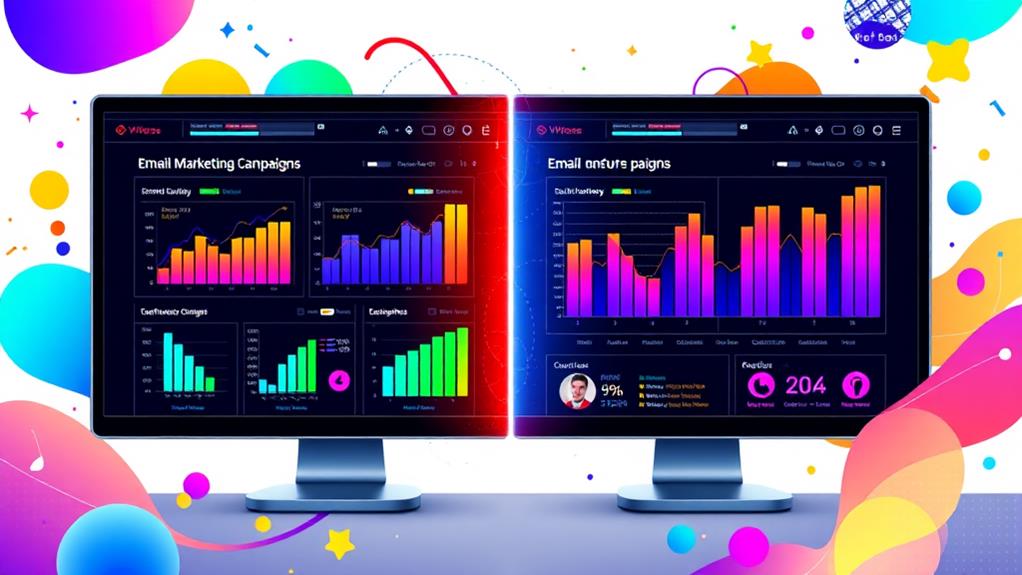To create engaging emails that convert, begin by defining clear objectives tailored to your audience's needs, ensuring content aligns with these goals. Optimize subject lines with action-oriented and personalized language to boost open rates. Use personalized sender information to build trust and strengthen connections. Design layouts that are mobile-friendly, using responsive design principles. Focus on crafting compelling content with storytelling elements and concise messaging. Develop effective calls-to-action using clear, urgent language, strategically positioned for maximum impact. Consistently analyze engagement metrics like open and conversion rates to refine strategies. Exploring these techniques can revolutionize your email marketing efforts.
Key Takeaways
- Use action-oriented language in CTAs and subject lines to drive engagement and improve open rates.
- Personalize sender information and subject lines to enhance trust and connection with recipients.
- Implement a mobile-friendly design with single-column layouts and larger text for improved readability.
- Create concise, value-driven content with storytelling and clear headlines for quick reader engagement.
- A/B test various elements like subject lines and CTAs to optimize email performance based on data-driven insights.
Define Clear Email Objectives
Defining clear email objectives is essential for crafting engaging and successful email campaigns. Establishing these objectives enhances focus, allowing marketers to align their content with the target audience's expectations. This alignment not only improves engagement but also increases the relevance of the message, which is critical for maintaining subscriber interest.
By segmenting the email list according to specific characteristics, marketers can tailor messages that resonate with each segment, thereby maximizing the impact of the communication. A strategic approach to email segmentation enables the delivery of content that addresses the unique needs and preferences of different audience segments.
By setting specific goals for each campaign, marketers can better track key performance metrics such as open rates, click-through rates, and conversions. This data-driven approach facilitates continuous improvement, allowing marketers to refine their strategies over time.
Moreover, A/B testing different objectives is essential for understanding what truly engages the audience. By experimenting with various messaging tactics, marketers can identify which objectives drive the best performance, thereby enhancing conversion rates.
Ultimately, clearly defined email objectives, combined with precise targeting and segmentation, lay the foundation for effective and compelling email campaigns.
Optimize Subject Lines
To guarantee your emails stand out in crowded inboxes, optimizing subject lines with action-oriented language and personalization is essential.
Personalized subject lines can boost open rates by up to 26%, creating a sense of connection that encourages engagement.
Action-Oriented Language
How can you guarantee your email stands out in a crowded inbox? The strategic use of action-oriented language in your subject lines is key. Action verbs are powerful tools that can drive engagement, compelling recipients to open your emails. For instance, words like "discover," "unlock," or "grab" can provoke an immediate response, while urgency tactics such as "limited time" or "act now" create a sense of immediacy, encouraging prompt action from your readers.
Research indicates that subject lines crafted with action-oriented language can greatly boost open rates, with 47% of recipients deciding to open an email based on the subject line alone. To maximize this impact, keep your subject lines concise, ideally under 50 characters. This not only enhances visibility but also guarantees that your message is straightforward and easily understood.
Furthermore, A/B testing different action-oriented subject lines is a strategic approach to understanding what resonates best with your audience. By experimenting with various phrases and calls to action, you can fine-tune your messaging for best engagement and conversion rates.
Engaging questions or urgent calls to action can further spark curiosity, driving recipients to explore your email content.
Personalization Boosts Opens
In the competitive world of email marketing, personalization stands as a strategic differentiator that can greatly enhance open rates. By tailoring subject lines to align with recipient behavior, marketers can see a notable increase in engagement, with studies showing a 26% rise in open rates. This trend underscores the significance of personalization as a key component in crafting effective email campaigns.
Incorporating the recipient's name into the subject line not only taps into current subject line trends but also establishes a sense of familiarity and relevance, prompting recipients to click and explore further.
To maximize effectiveness, subject lines should be concise, ideally under 50 characters, to accommodate the 61% of emails opened on mobile devices. This strategic brevity guarantees the entire message is visible, reducing the risk of truncation that can lead to missed opportunities.
Additionally, employing action-oriented language, such as "Discover Your Personalized Offer," can stimulate curiosity and drive interaction. A/B testing various personalized subject lines is essential for understanding which approaches resonate best with distinct audience segments.
Personalize Sender Information
Personalizing sender information in your email campaigns is a strategic move that enhances brand recognition and notably increases open rates.
By using a recognizable and trustworthy sender name, such as "[Employee Name] at [Brand]," you foster a sense of familiarity and connection with recipients, which translates to a 26% boost in open rates.
This approach not only strengthens the relationship with your audience but also strategically positions your brand to achieve higher engagement and reduced unsubscribe rates.
Enhance Brand Recognition
Familiarity plays a pivotal role in enhancing brand recognition, particularly when it comes to personalizing sender information in email communications. Implementing a familiar format, such as "[Employee Name] at [Brand]," is a strategic move that strengthens brand consistency while simultaneously appealing to audience segmentation.
By guaranteeing that recipients recognize the sender, brands can build trust and foster stronger relationships over time. Consistency in using personalized sender information across all email campaigns not only reinforces brand identity but also paves the way for a seamless and coherent brand experience.
The impact of personalized sender information on engagement metrics is substantial. Studies reveal that emails featuring familiar sender names yield a 26% increase in open rates, underscoring the importance of familiarity.
Furthermore, click-through rates can see a 14% improvement, which highlights how personalized sender details can drive recipient action. Segmenting audiences based on behavior and preferences allows brands to tailor sender information in a way that resonates with different groups.
This targeted approach guarantees that emails feel relevant and engaging, enhancing the overall effectiveness of email marketing strategies. In sum, personalizing sender information is a key tactic for enhancing brand recognition and driving email performance.
Increase Open Rates
Crafting compelling email campaigns requires strategic personalization, particularly in sender information, to greatly increase open rates. One effective approach is to incorporate the format "[Employee Name] at [Brand]," which enhances sender familiarity. This method makes emails feel more personal and relatable, boosting open rates by 26%. The familiarity of a recognizable name fosters a sense of email trustworthiness, making recipients more inclined to engage with the content.
Moreover, utilizing sender names from prominent team members can notably impact trust and credibility. When recipients recognize and trust the sender, they are more likely to open and interact with the email. This practice not only optimizes immediate engagement but also cultivates long-term relationships.
Consistency in using familiar sender names across campaigns is essential. It reinforces brand recognition, which, over time, contributes to sustained higher open rates.
Strategic A/B testing of different sender names can further refine this approach. By analyzing which names and formats resonate best, businesses can optimize engagement based on empirical data.
Strengthen Recipient Connection
In today's competitive digital landscape, leveraging personalized sender information is a strategic imperative for strengthening recipient connections. By employing formats like "[Employee Name] at [Brand]", emails become more familiar, enhancing emotional resonance and increasing open rates. Familiarity breeds trust, and this approach can greatly boost engagement.
Segmenting your audience using audience insights is essential; by understanding behavior and preferences, you can craft messages that resonate on an emotional level, leading to higher conversion rates.
Moreover, incorporating the recipient's name in the email greeting and throughout the content can improve engagement, with studies showing a 14% increase in click-through rates. Personalization extends beyond just names; dynamic content reflecting past purchases or interactions adds relevance, fostering a stronger connection and loyalty to the brand.
- Personalized Sender Information: Format emails as "[Employee Name] at [Brand]" for increased familiarity.
- Dynamic Content: Tailor messages with past interactions to boost relevance and connection.
- Subject Line Personalization: Use techniques like name integration for a 26% increase in open rates.
- Audience Segmentation: Leverage audience insights to create emotionally resonant, personalized content.
Strategically implementing these personalization techniques transforms emails into powerful, conversion-driving tools.
Design Mobile-Friendly Layouts
With a considerable majority of over 61% of emails being opened on mobile devices, optimizing for mobile-friendly layouts is no longer a luxury but a necessity for maximizing engagement and conversion rates.
Mobile usability is paramount; therefore, employing a single-column layout can greatly enhance readability, allowing users to effortlessly navigate and digest content without the need for horizontal scrolling. This strategic approach not only improves user satisfaction but also increases the likelihood of conversion.
Responsive design is another critical component, guaranteeing emails automatically adjust their formatting and images according to the device being used. This adaptability assures a consistent user experience across various platforms, thereby maintaining engagement rates.
Larger text sizes, at least 14px, and buttons measuring a minimum of 44px x 44px cater to touchscreen users, making interaction seamless and intuitive.
Testing emails on different devices and email clients is essential to confirm that design elements appear correctly and functionality remains intact. Discrepancies in display or usability can lead to diminished engagement, undermining the email campaign's effectiveness.
Craft Compelling Content
Having established the importance of mobile-friendly designs, attention now turns to the art of crafting content that captivates. The essence of engaging email content lies in its ability to deliver value through storytelling techniques that forge an emotional connection. This emotional appeal is essential in prompting readers to take action.
Given the fleeting nature of attention spans—averaging just 10 seconds—conciseness becomes a strategic imperative. Each word must be meticulously chosen to convey the message succinctly while maintaining the narrative's allure.
To amplify the content's impact, consider integrating customer testimonials. These not only bolster credibility but also foster trust, markedly enhancing conversion potential. The strategic use of bullet points serves as an effective method for making key information easily digestible, ensuring the reader can swiftly grasp the email's main messages.
Additionally, clear and compelling headlines are fundamental. They must be designed to be immediately scannable, offering quick comprehension and drawing the reader into the content.
- Harness storytelling techniques to build emotional connections.
- Prioritize concise, value-driven content to capture fleeting attention.
- Utilize customer testimonials to enhance credibility and trust.
- Employ bullet points for clarity and ease of information scanning.
Strategize Effective CTAs
To maximize the impact of your email campaigns, crafting effective Calls to Action (CTAs) is essential. A strategic approach to CTA placement and urgency messaging can notably enhance your emails' performance. Clear and actionable language in CTAs can boost click-through rates by 47%, highlighting the importance of using verbs that convey urgency and value, such as "Shop Now" or "Get Started."
Incorporating urgency messaging not only encourages immediate action but also communicates the value proposition effectively. Positioning CTAs prominently within the email, ideally above the fold, is vital for visibility and engagement. This placement guarantees that users notice the CTA without needing to scroll, thereby increasing the likelihood of interaction.
Additionally, employing contrasting colors for CTA buttons can make them stand out against the email background, improving click rates by up to 30%. Limiting your email to one primary CTA can reduce confusion and enhance focus, leading to better conversion rates.
However, including a secondary, less prominent CTA can cater to users not yet ready to commit. Regularly A/B testing different CTA placements, styles, and wording will provide insights into what resonates best, facilitating continuous optimization of your campaigns.
Analyze Engagement Metrics
Crafting effective Calls to Action is only part of the equation for successful email marketing; the next step involves a thorough examination of engagement metrics to truly understand the efficacy of your campaigns.
Effective metric analysis allows marketers to fine-tune their strategies by comparing engagement benchmarks across various metrics. For instance, tracking open rates—typically around 20-30%—is critical as it reflects the resonance of subject lines and sender names with recipients.
Moreover, click-through rates (CTR), with an average benchmark of 2.5%, provide insight into how compelling your content and CTAs truly are. Conversion rates, ranging from 1% to 5%, offer a direct measure of success, indicating the percentage of recipients who take the desired action.
Additionally, analyzing unsubscribe rates, which average between 0.2% and 0.5%, can reveal content relevancy and audience satisfaction. To optimize engagement, regular A/B testing of email components such as subject lines and layouts can lead to a 20-30% increase in engagement by identifying what resonates most effectively.
- Open Rates: Gauge subject line effectiveness.
- Click-Through Rates: Measure CTA engagement.
- Conversion Rates: Assess campaign success.
- Unsubscribe Rates: Evaluate content relevance.
Strategic metric analysis is indispensable for refining your email marketing efforts.
Frequently Asked Questions
How to Create Emails That Convert?
Creating emails that convert involves crafting compelling subject lines and employing email personalization. Strategically focus on mobile-friendly design and concise, value-driven content with clear CTAs to enhance engagement and drive higher open and conversion rates.
How to Make an Email Look Engaging?
To craft visually engaging emails, strategically apply visual hierarchy and color psychology. Use contrasting colors for emphasis, ensuring key elements capture attention. This approach enhances readability and engagement, ultimately driving improved interaction rates and achieving conversion objectives.
How Do I Create a High Converting Email Sequence?
To create a high converting email sequence, employ a segmentation strategy to tailor content personalization for your target audience. Utilize email automation for timely delivery, craft compelling subject lines, and design focused call-to-actions to maximize engagement and conversion.
How Can I Improve My Email Conversion?
To improve email conversion, strategically craft compelling subject lines under 50 characters to boost open rates. Enhance effectiveness by designing visually distinct calls-to-action, ensuring prominent placement, and testing variations to optimize engagement and conversion outcomes.
Conclusion
In conclusion, the strategic implementation of clear email objectives, optimized subject lines, personalized sender information, mobile-friendly designs, compelling content, and effective calls to action are essential in crafting emails that engage and convert. An analytical approach to each of these elements guarantees that emails are not only visually appealing but also functional in driving the desired outcomes. Regular analysis of engagement metrics further refines these strategies, enhancing the overall efficacy of email marketing efforts.




